For this loaf I wanted to try sifting out the larger bran flakes. I finally purchased a #40 sieve. Taking all the flour, I sifted it through the #40 sieve extracting about 46.5 g of large course bran flakes from 492 g of the stoneground organic whole wheat flour. I intended on scalding the bran, but made an error adding an equal part by weight of room temperature water then remembering that I wanted to scald so added the second equal part by weight boiled water. The bran was mixed to ensure it was fully hydrated and then cooled overnight in the fridge to avoid any microbial activity.
The stiff levain was built and left to ferment overnight at 74ºF.
The next morning the pH of the levain was 4.17 and was then broken down in water, then the sifted flour was added for a fermentolyse. After 10 mins of rest I started gluten development with slap and folds then gradually added the hold back water in several aliquots using Rubaud to fully incorporate the water well. During the addition of the second aliquot of water the salt was added. In total at this point 250 slap and folds were done to develop the gluten in anticipation of the bran interfering with the gluten sheets. After a rest of 20 mins the hydrated bran was added through a series of stretch and folds in the bowl followed by slap and folds until the bran well well incorporated. The pH was 5.55 at this point.
30 mins one bench letterfold
Then at 30 mins intervals coil folds x 4 done
A pH drop of 1.0 was targeted for shaping
When pH 4.55 reached rise was 42%, shaping was done.
Warm final proof done targeting a pH drop of a further 0.3 at which time baking was started.
Pre-heat oven with cast iron skillet in the oven and set up for open steam baking in anticipation of pH targeted baking.
30 mins prior to baking, pour 1 L of boiling water into metal loaf pan with Sylvia towel and place on baking steel on the lowest rack of the oven.
Once oven reaches 500ºF turn dough out of banneton, brush excess rice flour off, score and then brush with water. Transfer to oven. Pour 250 mL of boiling water into the cast iron skillet on a high shelf, high enough that the dough have fully bloom. Drop temperature to 450ºF and bake with steam for 25 mins. Then vent oven and remove all steaming gear and drop temperature to 425ºF. Bake for another 25-30 mins rotating as needed.
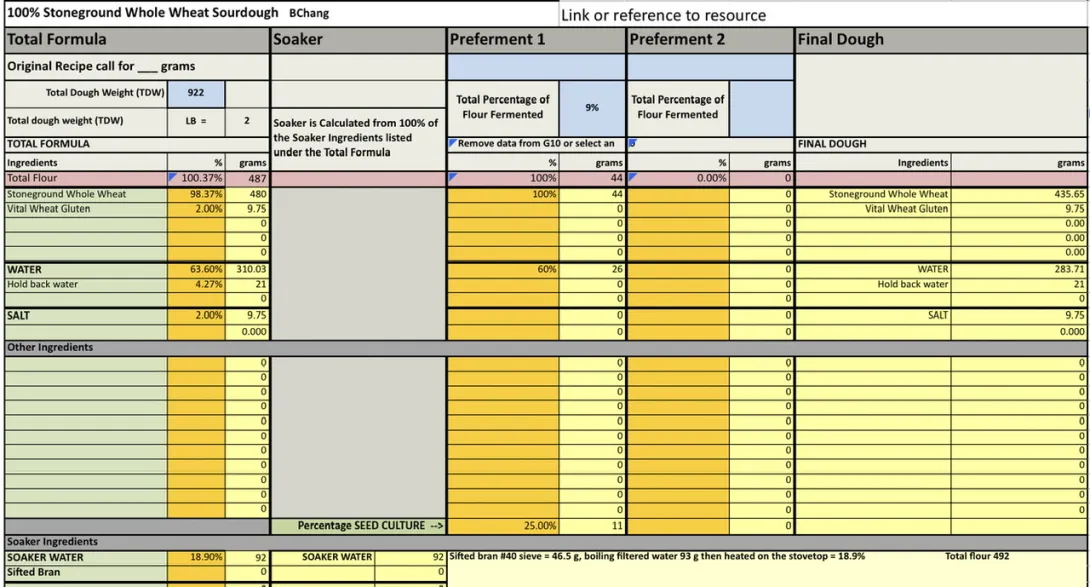
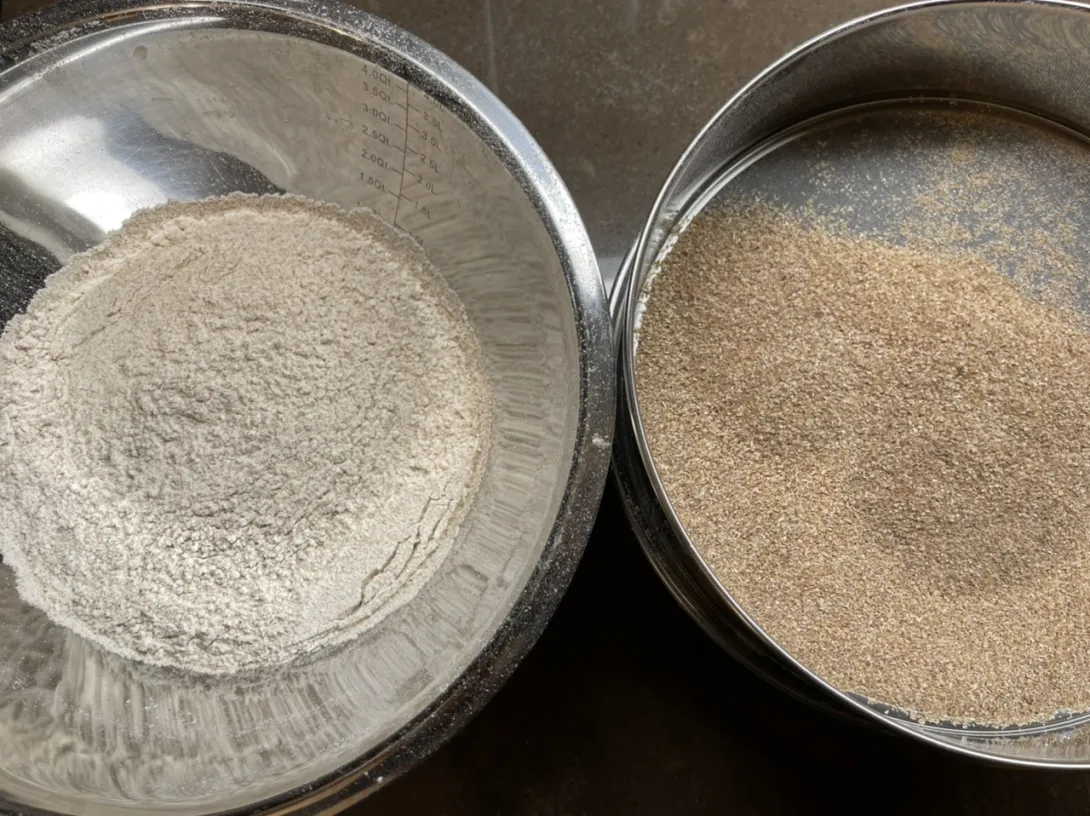
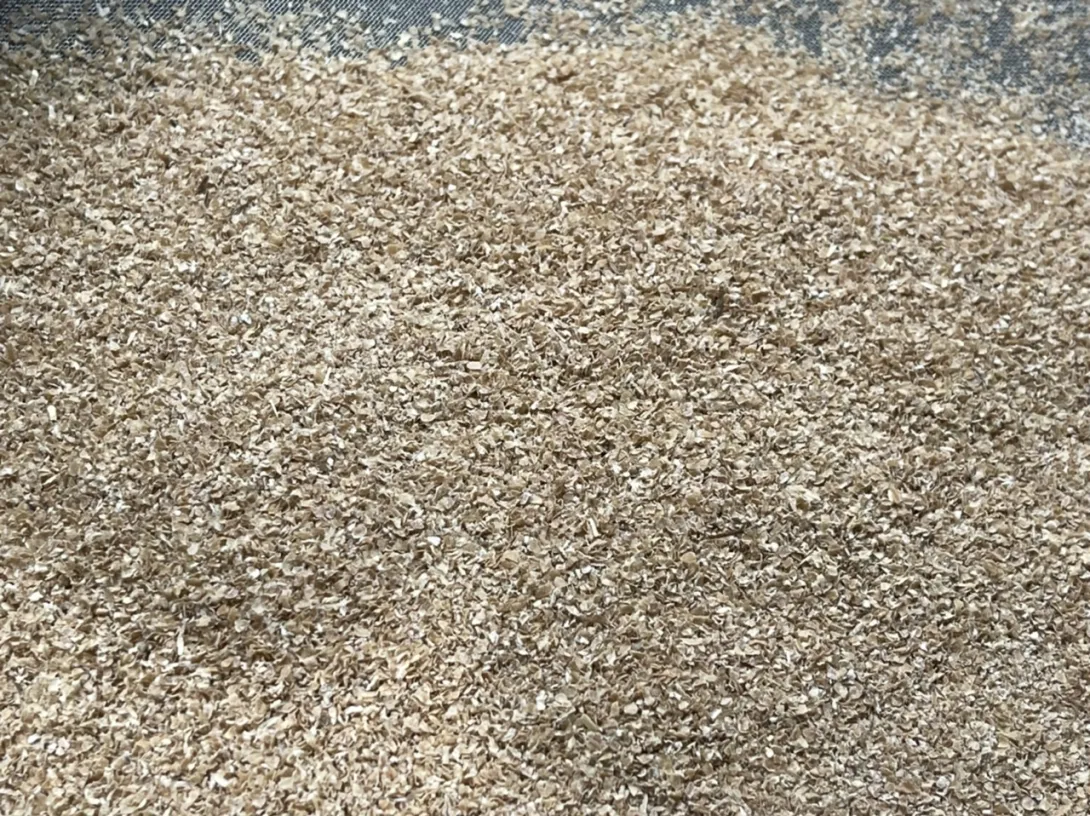
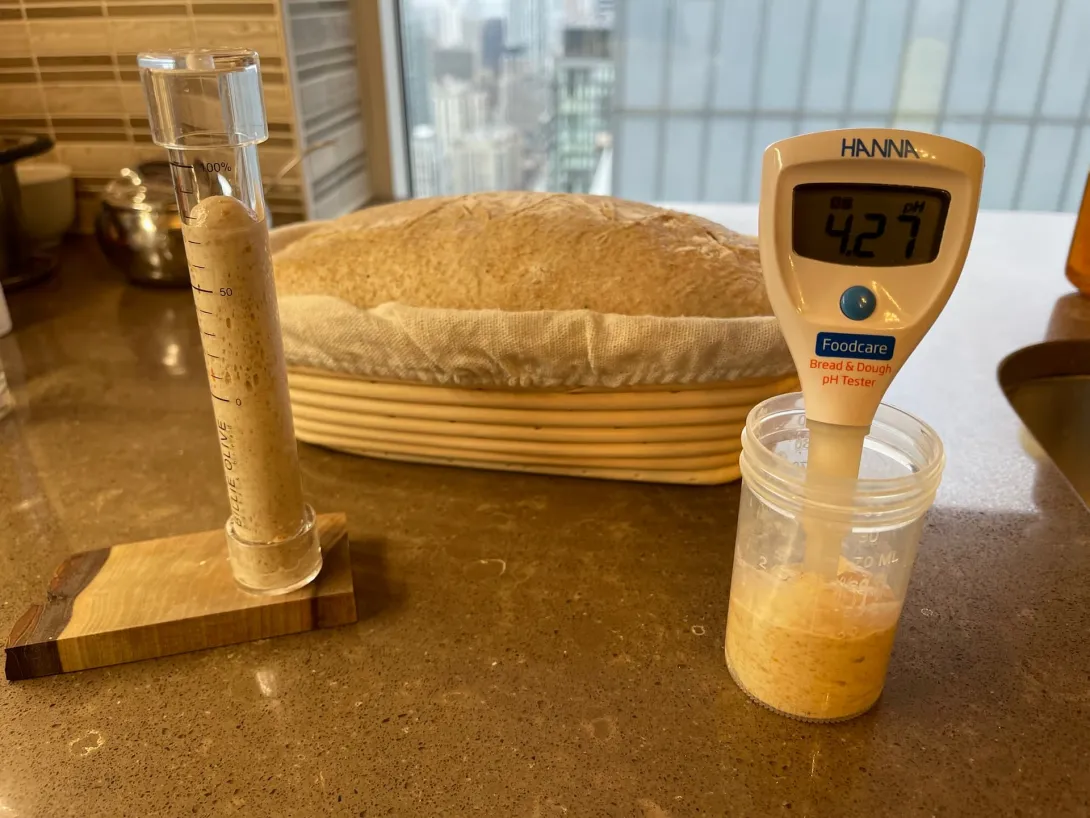
As you can see from the aliquot jar, this dough had about 75% rise at the time of baking.
Time lapse video of the oven spring first 25 mins of open steam baking.
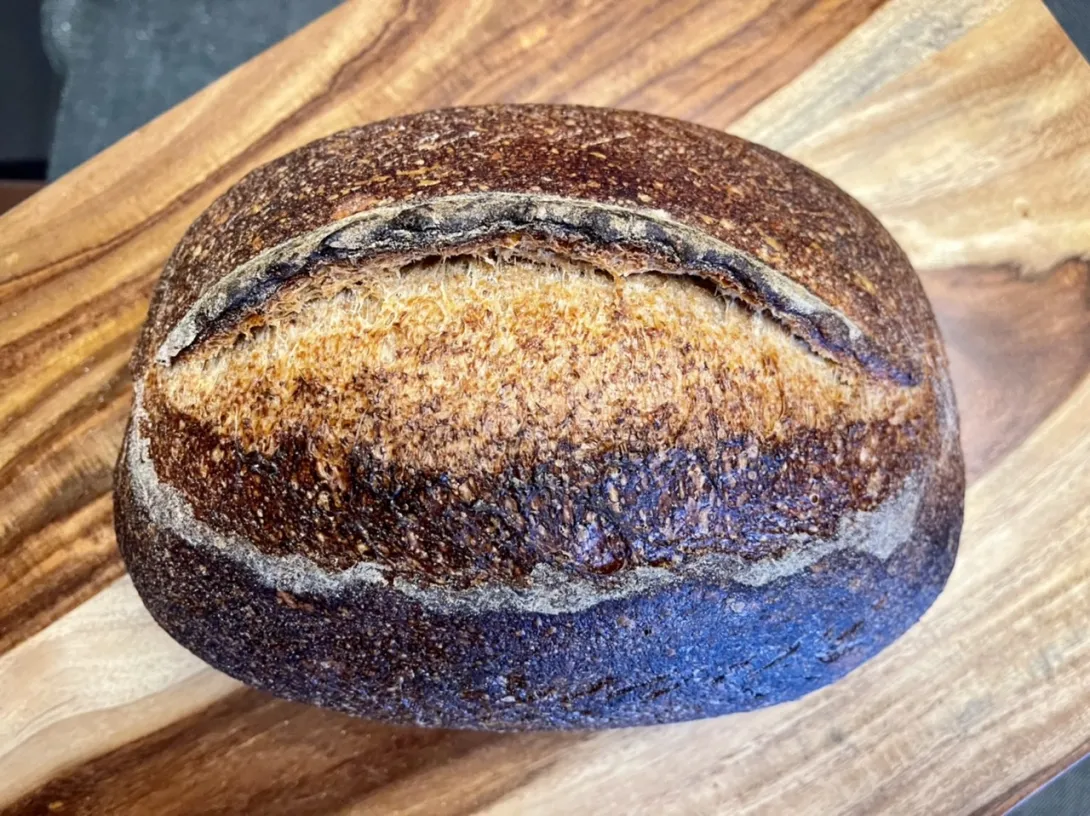
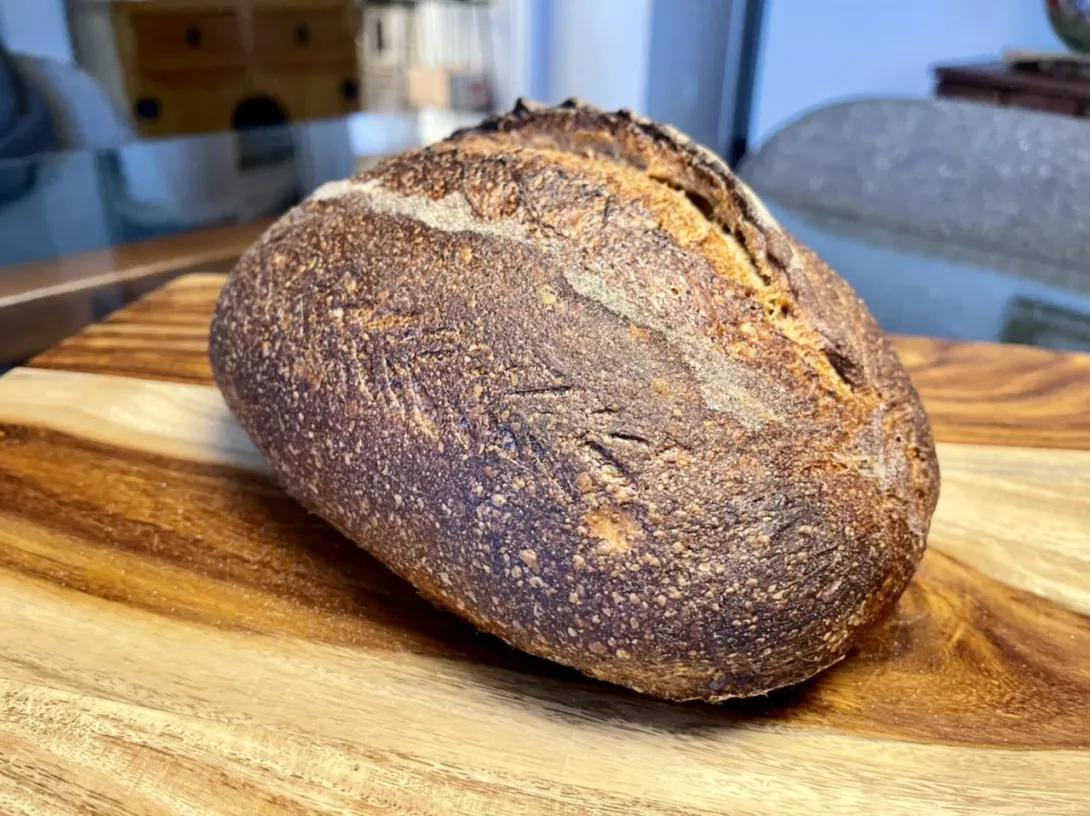
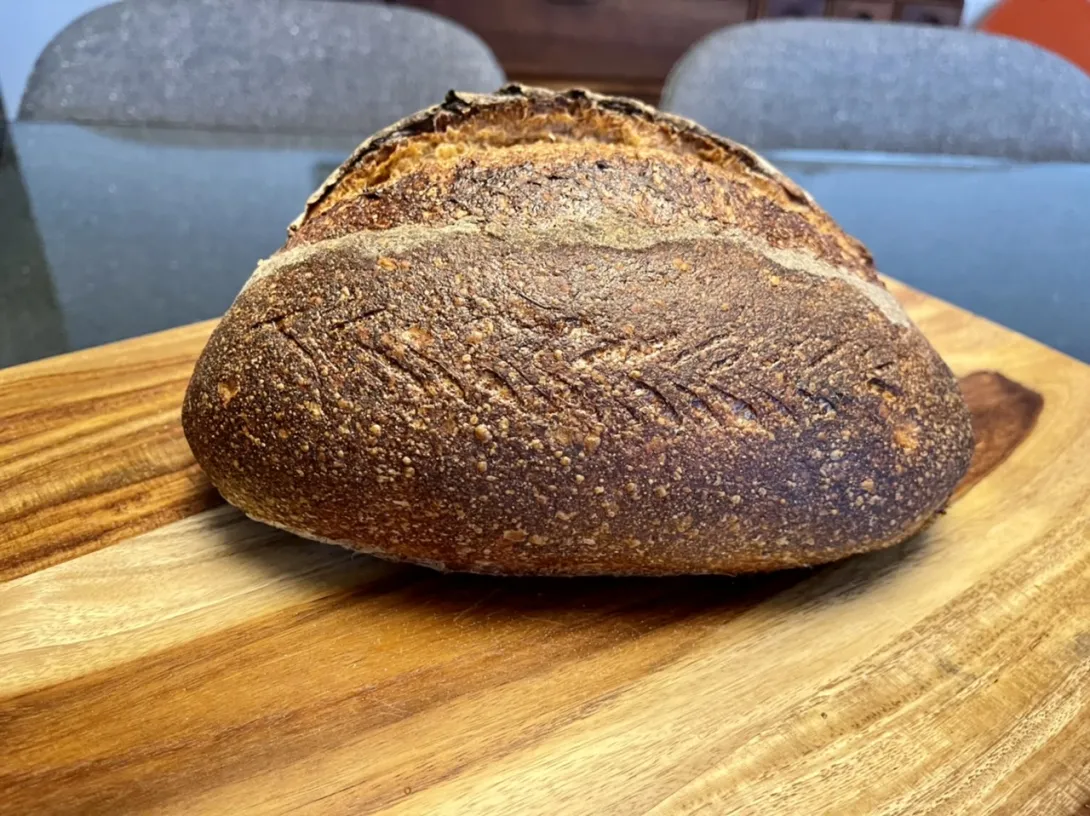
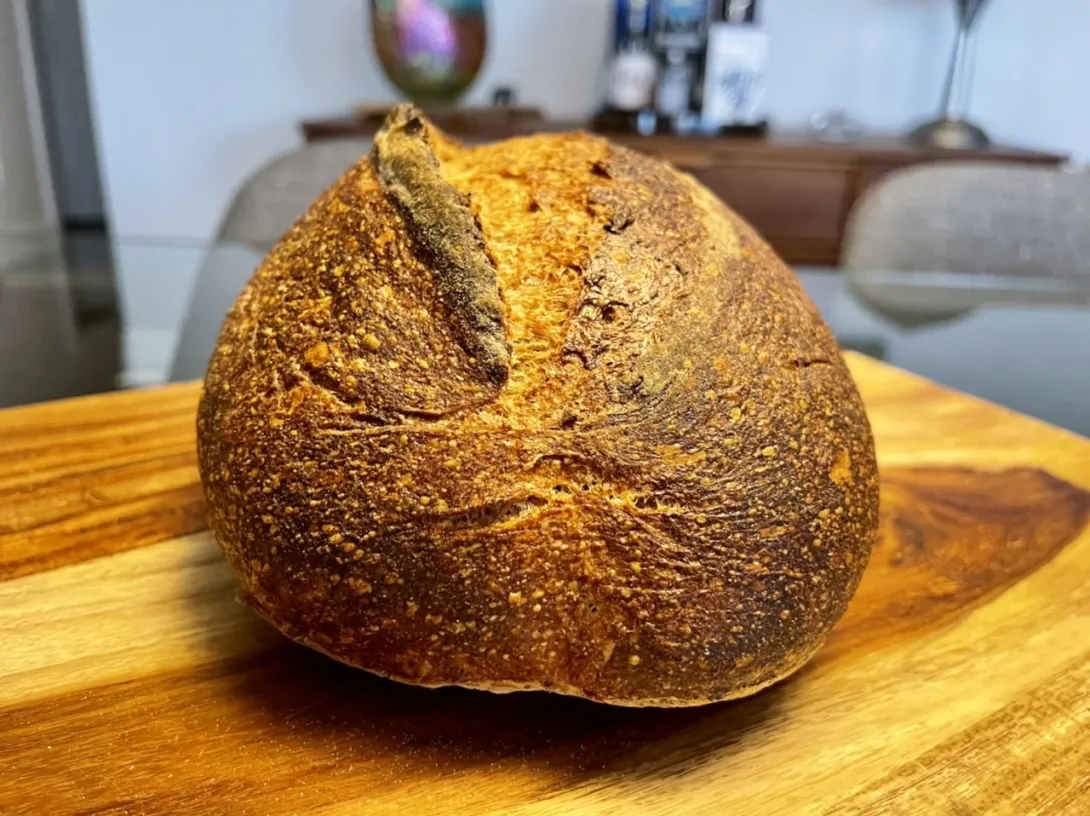
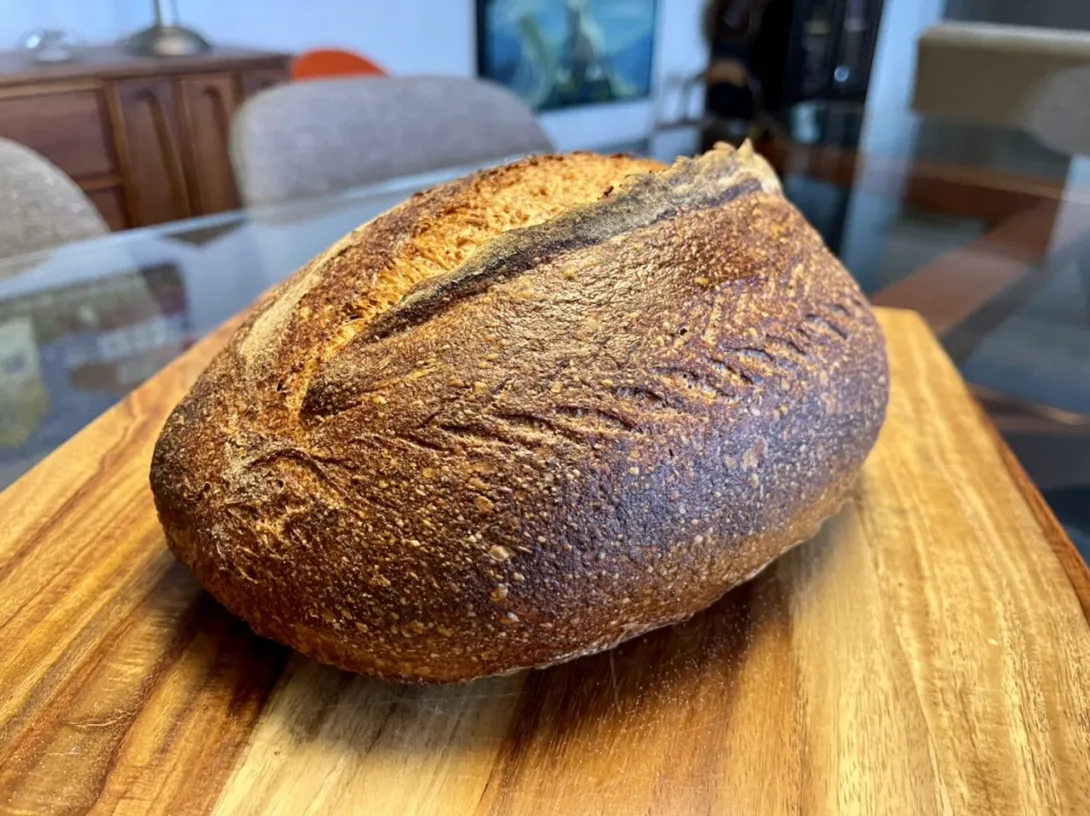
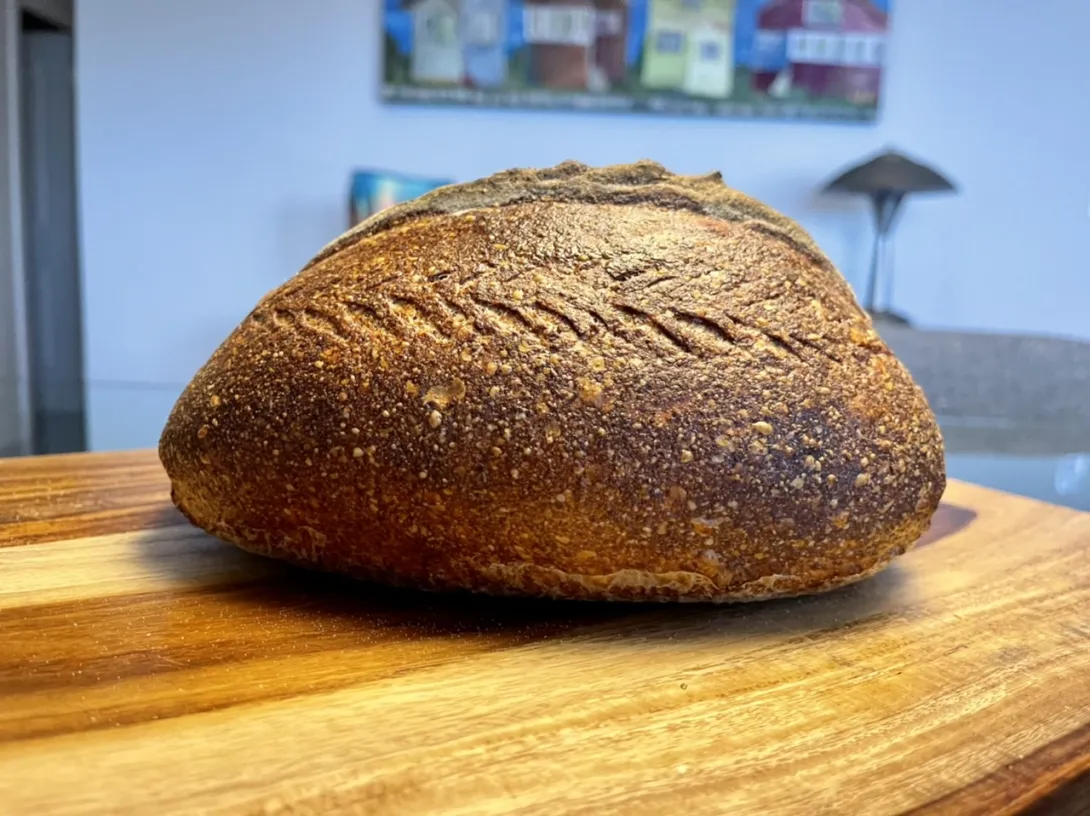
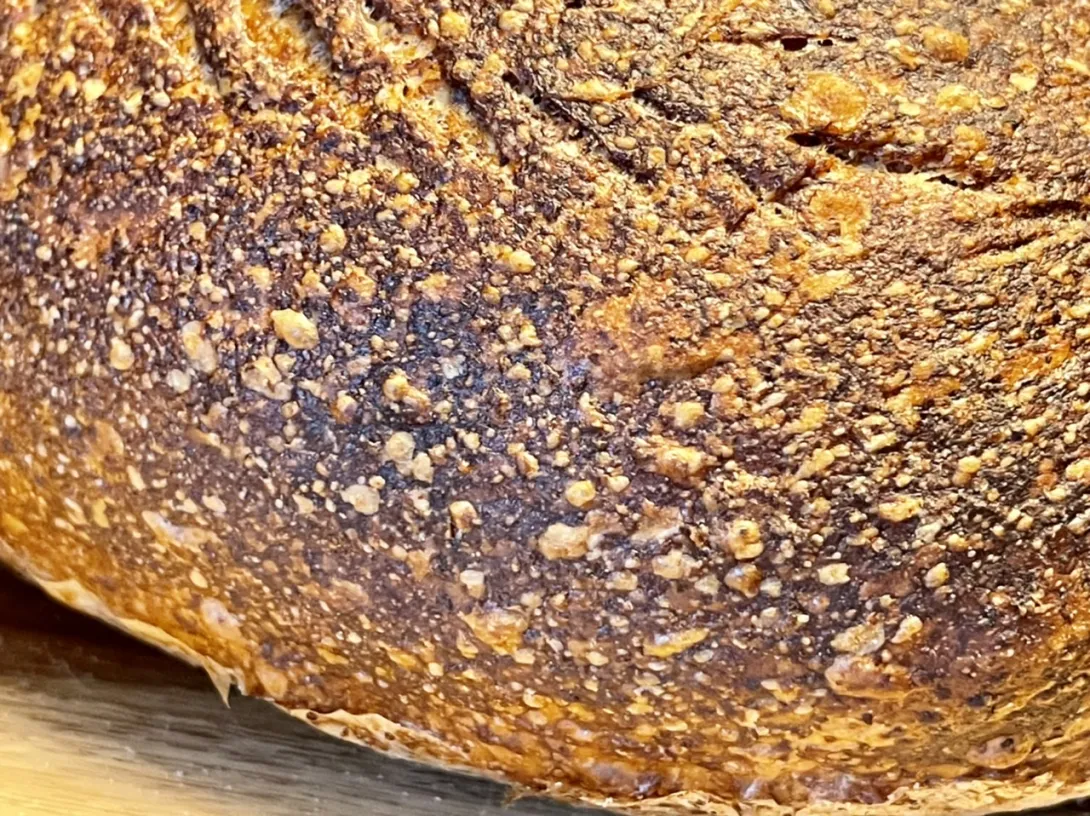
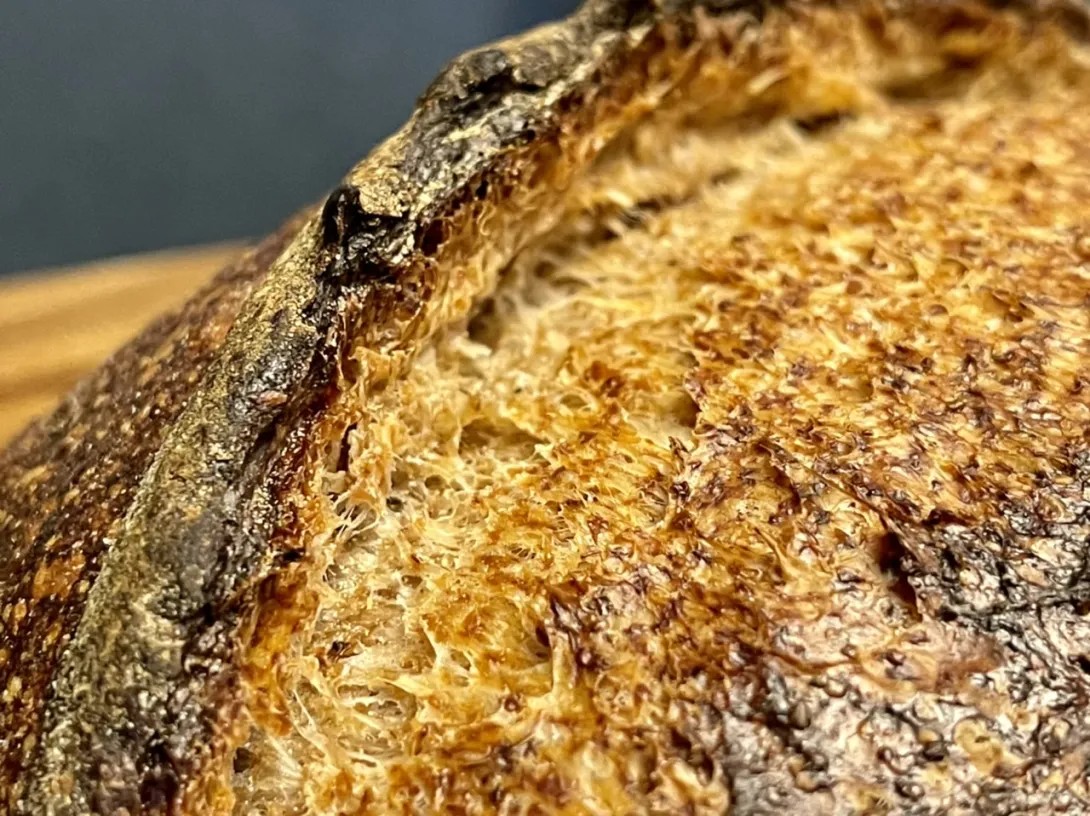
I’m quite pleased with this bake especially considering the issues I’ve had with baking 100% whole red fife in the past. For a first try on my own recipe, I’m quite happy. Now the bloom could be better and I know that the hydration despite a calculated 86% approximately should be higher. I wasn’t sure how much extra water the scaled bran would contribute to the dough once it was added. In the end, I don’t think it added much so next time I’ll have to bassinage even more water into the dough. I’ll know more about how this turned out once it is sliced.
- Benito's Blog
- Log in or register to post comments
Benny, that is one gorgeous loaf of bread! Love the bold bake, the rise looks great, and I always get a kick out of your decorative scoring. :) I've got a 50% whole wheat formula that I just created on a whim, and your great bake is making me even more excited to get after it (just waiting on my levain right now.)
Gotta get me one of those aliquot jars, too! :)
R
Thank you Rich that is very kind of you to say. I hadn't scored warm dough recently and was reminded of how it kind of sticks and drags more to even a fresh blade. I "think" I have the pH target goals for fermentation figured out now, especially now that this loaf appears to be successful. I definitely need to bake this again with more hydration, the dough was too strong the whole way through bulk and never really needed to tighten up. Although I did a gluten stress test on the dough, I didn't test above 85% hydration which in retrospect I should have done. I should also test the sifted flour separately too.
That aliquot jar was sent to me to test by an outfit on Instagram. It is a bit fidgety to use, but once set up, it is actually really great. The IG account if you want to look into getting this exact kit is billie.olive You certainly do not need anything fancy like this, but I have to admit that I like using this now that I have it.
Benny
Thanks for the pointer on the jar. I would guess that really any straight sided vessel would work to give an accurate depiction of the rise (small diameter being important so you don't need a large piece of the dough as a sacrifice. I'm thinking some sort of graduated cylinder made of lab glass or similar would work (and they are easy to find.)
You are many steps beyond me in the science of bread for sure! I do have a pH meter, though, from my brief stint trying to make cheese, so nice to know that I could use it for bread if I wanted to nerd out a bit more! :) (no offense intended.....I hold bread nerds in high regard!) :)
Rich
Prior to getting this new setup I was using medical specimen jars which are free, for me at least, they work perfectly perfect straight sides that are parallel and just wide enough to be able to get the dough into it and press it down with your fingers. But yes you can use almost anything similar in size.
I’m happy nerding out on stuff like this, no offense taken, it is a compliment.
Benny
Very good looking bake, Benny, looks very tall, must have had great oven spring. That measurement jar looks very tall, wondering how easy is it to pack the dough down to the bottom. I use a spice jar as shown which is about 1.5" diameter and it takes a little effort to jam the dough down.
Thank you Ming, I’m pretty happy with this but I believe I need to increase the hydration to improve it.
In terms of the aliquot jars, as in my post explaining how I use aliquot jars, I still have the medical sample jars that I have always used. This new aliquot jar from billie.olive is very interesting. The tube itself is open ended on both ends. You insert one end into the dough, into the other end you insert a device that creates a vacuum when you manually pump it. I believe it is actually just a wine device meant to remove the air from an open wine bottle. As the vacuum increases the dough is drawn up into the tube. Once you get just past the 0 mark you remove the tube from the dough and slice it off. You then place a cap on the bottom of the tube and then another cap that has an opening and a filter on it for the top so that the gases can escape as the dough ferments. To clean, it comes with a plunger that you just pass down the tube after you’ve removed both caps and voila the aliquot of dough is gone, then just a quick cleaning and done.
Thanks Benny for the info of this interesting measurement jar. I might have to check it out.
Regarding your bake, I am not sure what to improve, as Kristen's 100% whole grain sourdough linked below is a yardstick for me and I can't see much different between yours and hers. Very envious indeed!
How To Make A 100% Whole Wheat Sourdough Bread - YouTube
That’s very kind of you Ming, Kristen is a fabulous baker. If you haven’t checked it out already, she was part of a Community Bake here two years ago when we baked her basic open crumb sourdough.
Benny
I have not seen that CB, I will need to catch up on it. By the way, it looks like my measuring sample had a ball on the top like yours, looks like a point where the yeast would die in the oven :).
Benny, great looking loaf! Thanks for the detailed write-up; very useful. I suspect you keep notes for future tweaking.
Cheers,
Gavin
Thank you Gavin, much appreciated. I definitely keep tons of notes on each bake with notes at the end with suggestions for improvement, that is often a long list 😂
I’m not mad at the crumb but do think the hydration does need to be increased. Tasty stuff, slight tang only with great wheat flavor and little bitterness from the bran.
Image
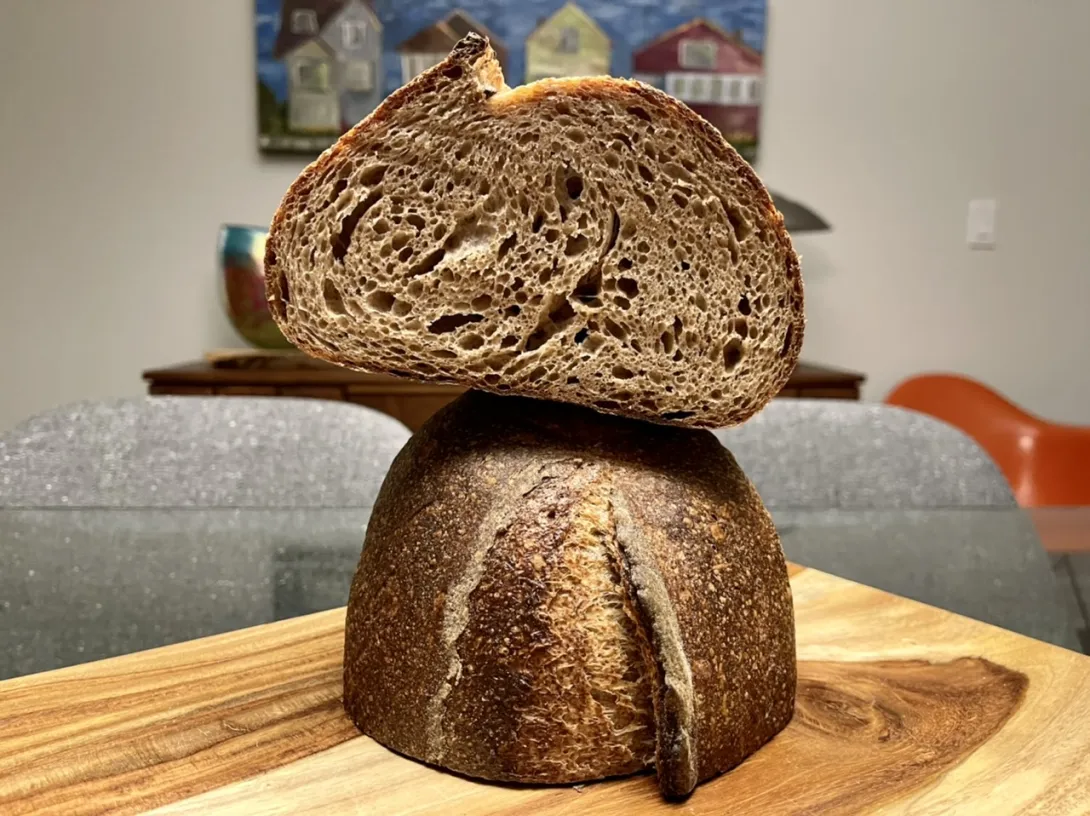
Image
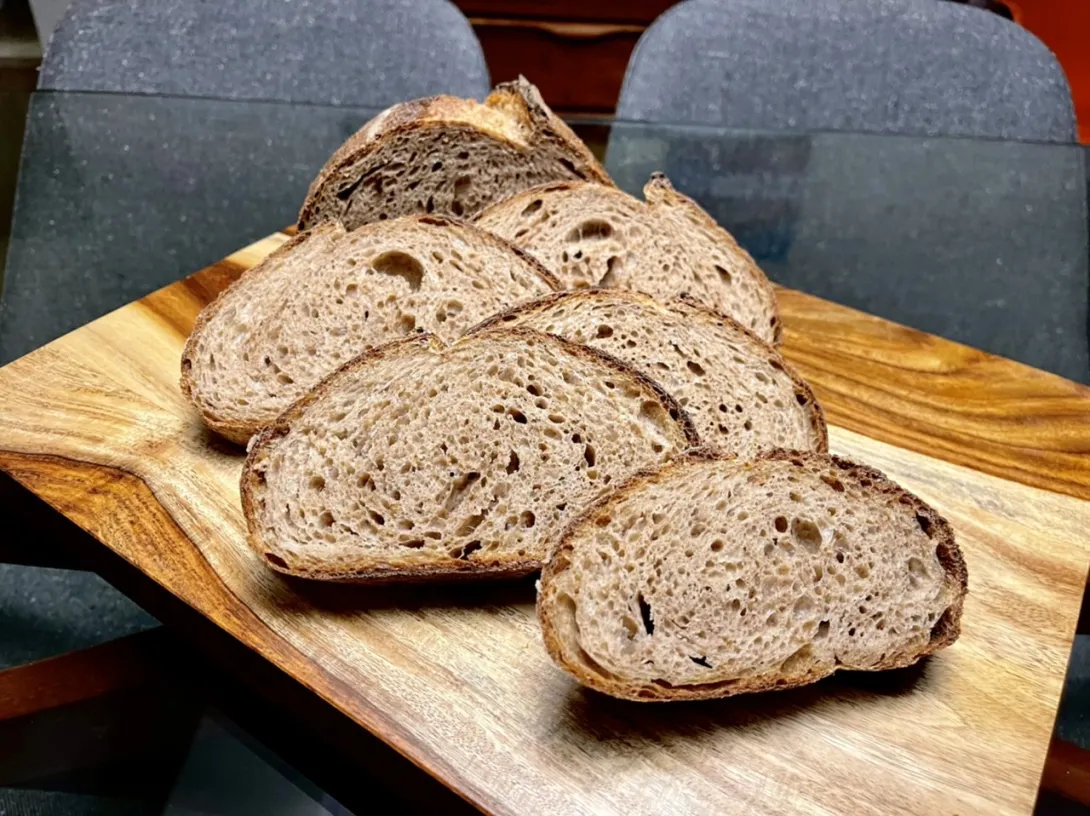
Image
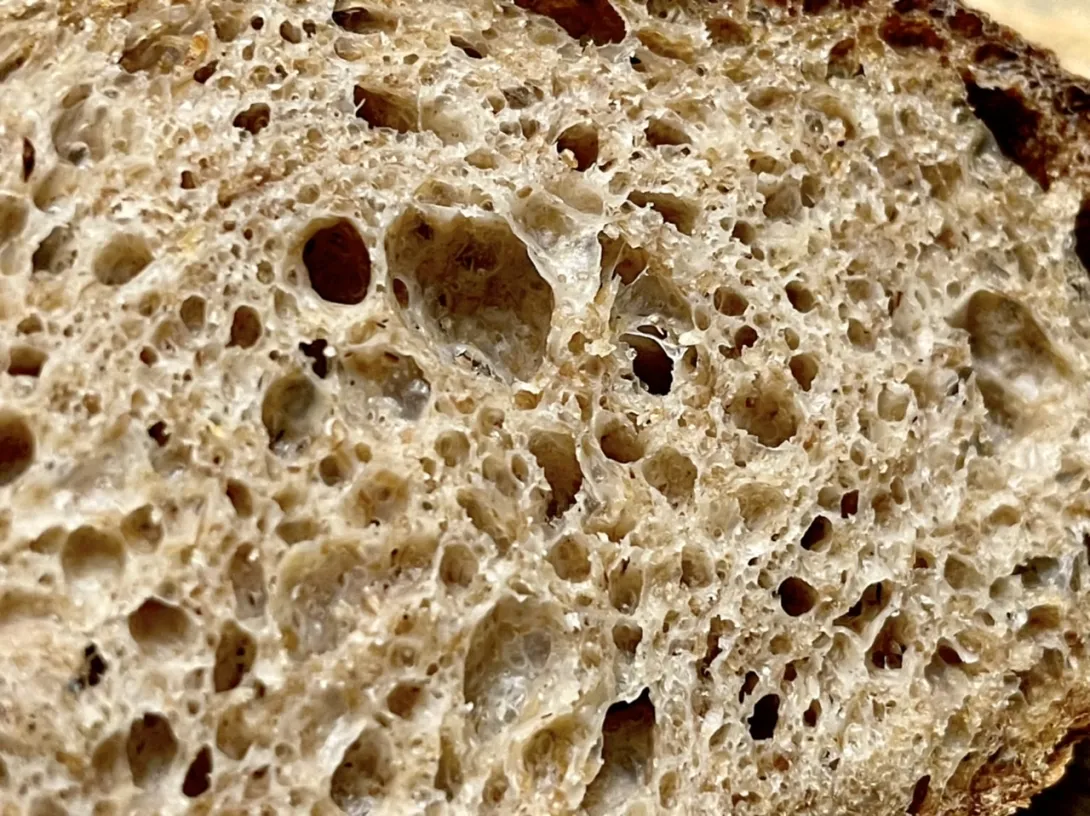
Great looking bread and crumb!!
Thank you very much 🙏🙏🙏🙏 George.
Happy Baking
Benny
And I love the color of the crumb.
Thank you very much jl, overall this was a great bake for whole wheat for me and motivates me to do more 100% whole grains.
Benny
Lovely work as usual. Scald crumbs can be more cakey so it's cool that you got something more open.
I hope you have a chance to try a full scald left out overnight. I think it should be soft enough to incorporate without worrying about gluten damage, and might clear up any bitterness (I assume you're cooling it completely before putting in the fridge to avoid affecting nearby foods like milk products),
For my next Borodinsky scald, I plan to keep it heated overnight, which is supposed to better reflect the slow cooling the Russians got from their huge 100kg batches of dough cooling down... A longer-maintained heat supposedly helps improve flavour and sweetness.
I used a small buckwheat scald in a trio of durum atta loaves... the scalds produced a sweet, firm, moist, cakey crumb.
Thank you David, as you know I only scalded the bran and let it cool before putting it into the fridge. I wouldn’t think that only scalding the bran would affect the crumb making it cakey.
I’m looking forward to your upcoming scalding bakes.
Benny
I know you are always striving for perfection but I have to say your crumb really can’t get much better than this 👏👏. You’re next step is a mill! Once you take the plunge you won’t look back.
Happy baking,
Ian
Thank you Ian, very kind of you to say that. If we ever move into a place with a larger kitchen and more storage a mill might be in the picture. Until that time at least there are places to buy locally milled organic high quality flours around here.
I am still planning to try again with higher hydration and use this method again.
Benny
Really nice bake Benny. I think the bloom and the crumb look about as good as you can get for 100% whole wheat. You seem to be dialing in your pH targets quite well. I see you targeted a pH delta versus a fixed value. How are you determining the target delta?
Thanks so much Troy. As I have been using pH for a little while now with other bakes I had the thought that one cannot target a fixed pH as the goal for all types of dough. Given the varying buffering abilities of different flours, if you did, the degree of fermentation would be different and some would end up over and others under fermented. So it occurred to me that I needed to determine a pH delta. So looking at my bakes and also bakes of another baker on IG, it appeared to me that the ones that I did that turned out the best had an overall delta of 1.3 from mix including the bran in the case of this bake to time of bake. Looking at the crumb and oven spring I was able to achieve with various bakes and what I’m comfortable shaping a pH delta of 1 seemed ideal for me. I’m now starting to think that I no longer need the aliquot jar for rise anymore and that pH can fully guide fermentation for me. We’ll see about that after more bakes with more varied types of dough.
I know great bakers can rely solely on their senses, I find that by using these additional tools I am gradually training my senses and hope eventually have to be able to bake without them.
I think targeting a delta pH makes sense as it's definitely a better indicator of microbial activity than targeting an absolute value assuming you have consistent starter culture make-up and consistent water.
One thing you may want to start adding to your notes is the alkalinity of your mix water. Alkalinity is a buffer, and if alkalinity increases, it will take more microbial activity to achieve your delta pH. Alkalinity is usually determined by titrating with a sulfuric acid standard to a pH endpoint of 4.3, but I don't know that you need to go to that level of detail. You could just as easily develop a reference by looking at how many drops of white vinegar it takes to get a delta pH of 1 or how many drops it takes to get to a pH of 4.3. If you have a good well water source, I doubt it changes much. If you use filtered municipal water, it may not change a lot either (maybe seasonally). However, if you use bottled water and different brands of bottled water, I could see it shifting quite a bit from bake to bake.
Keep us posted! I have a good pH meter for use in liquid levains, but I don't have a good tip for getting measurements in dough.
Fortunately my partner does water testing at his job and has been doing this for many many years. He tells me that our water is actually quite consistent and doesn't change much. As such, I've never really bothered to check our water pH at all. However, your point is well taken. And you're right I do use filtered municipal water and not bottled water.
I had a pH meter initially that didn't have a good tip for dough and gave up on using it after a while, but now with the Hanna Bread and Dough meter, I've been enjoying using it.
Benny
Perfect! Sounds like that's a variable you don't have to worry about.
Hi Benny,
Using a PH delta vs a fixed PH reading has been extremely enlightening for me as I've begun baking more 100% whole grain loaves. My question about your delta of 1 is if that changes depending on how mature your starter is? Do you always use your starter at the same PH reading? And if not, does using a younger vs more mature starter in your recipe change the delta?
Thanks!
Hi Elvis. I use my starter to build a levain anywhere from the day it peaked until up to seven days after feeding and staying in the fridge. No matter the state of my starter I will watch dough rise and pH, but overall I find pH delta to be more reliable than dough rise. I haven’t been taking the pH of my starter for quite a long time since I don’t use that data for anything. I also haven’t been measuring the pH of the levain, I always try to use it just when the dome is starting to flatten.
Benny
Hey Benny, I love this whole wheat loaf. Making a whole wheat sourdough with good oven spring and an open-ish crumb have been an elusive goal for me. Have you at some point struggled with 100% whole wheat using the exact same ingredient? If so what were the things you did that improved your bread? I remember when I struggled with white loaves a lot of my improvements came from using better flour/using a dutch oven over a stainless steel pot, so for this bread I am worried that my flour could be a problem. I use King Arthur's red whole wheat flour, which have a reputation of being a strong flour. With that in mind, I'm hoping that my techniques are holding me back and not the ingredients, but there's so many variables to manipulate I can't get a read on what to do.
I only recently started to use this particular flour so cannot say that I’ve had poor luck with it in the past. However, using this flour also coincides with improvements in my methods that I adopted only when I tried baking with this flour for the first time. The details of what I did are outlined above, but the most important thing I believe is the sifting out of the bran to scald it and developing the gluten in the dough before adding the bran back as if it is an inclusion. Next most important is knowing when to stop fermentation which especially for 100% whole grains is so important. Over the course of many bakes I came up with the notion that it is the change in pH over the course of bulk and final proof that we should aim for rather than a target pH value. These whole grain doughs start with a higher pH and if one targeted the same pH as you would for a white flour dough then these would be grossly over proofed. Finally, and I’m not sure I actually need this, is the vital wheat gluten. I haven’t yet tried doing this bake without it yet, but since I’m using a small amount that doesn’t affect the flavour, but at the very least makes the dough stronger I think it is helpful without any negatives to my palate.
Benny
I have seen people soaking the sifted bran but I've never heard of scalding it. What does it do that regular soaking cannot? Thanks for all the advice.
The main reason I scald it is that it seems to hydrate more rapidly with a scald than room temperature water.